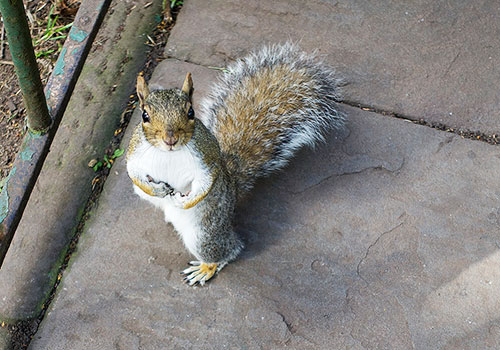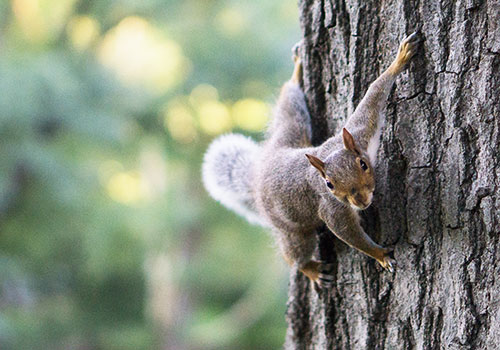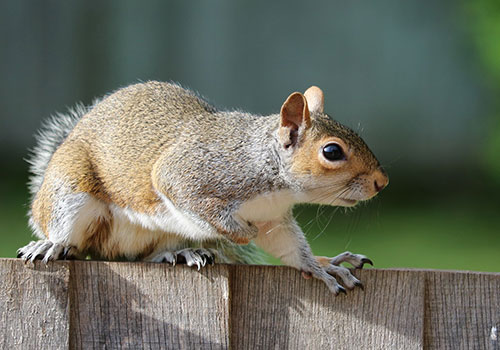Squirrels: Garden Friend or Foe?
Squirrels: adorable backyard wildlife, or pesky garden pest? It’s a hot debate in some gardening circles, and consensus may not come anytime soon. In polls, squirrels top lists of everyone’s favorite urban wildlife... and they also top lists of the most annoying pests.
But whether you view squirrels as fluffy friends, problem pests, or admirable adversaries, they are definitely a fact of our gardening lives.
Even as they dig up our newly-planted bulbs for the umpteenth time or try to take up residence in our attics, it’s hard to deny that Squirrels deserve our appreciation, or at least some respect. They even have their own appreciation day, celebrated January 21st, and we fully support that. Intelligent, social, and acrobatic, these are some pretty impressive creatures.
That being said, perhaps we can appreciate them all the more if we take some steps to cut down on the mischief they can cause in our gardens and homes.

A Brief History of Urban Squirrels
Many city-dwellers may find squirrels to be a nuisance, but to be honest, we humans have only ourselves to blame. While there are four native species of squirrels in western Washington, they tend to be shy creatures who favor snacking on pine cones in the woods. Believe it or not, the ubiquitous city squirrels that give us so much joy and trouble today were introduced on purpose.
European types thought it was a good idea to introduce eastern gray squirrels, native to eastern North America, to both the west coast of the United States and to Europe throughout the late 19th and early-mid 20th centuries. The idea was that they would add an extra touch of idyllic nature to urban parks and estates.
That choice has turned out to be a big mistake in Europe, where the introduced species is rapidly displacing native squirrels, with cascading ecological impacts. The impact of eastern grays on native Washington state species is less clear. Some ecologists think they may have a paw in native species declines. Others note that the introduced squirrels tend to stick to urban parks and gardens, whereas our native species prefer quieter, densely forested habitats. In this line of thinking, the decline of native species is more about habitat loss than directly because of eastern gray squirrels.

What Makes Them So Impressive – & So Pesky
In the spirit of squirrel appreciation, here are just a few fun things to know about what makes squirrels so darn adaptable, impressive, and impossible to keep out of your bird feeders:
-
- They are double-jointed: (We know... AH!) They can rotate each of their paws 180 degrees. That’s why they are one of only a small handful of creatures that can climb down a vertical tree or pole head-first.
- Their fluffy tails aren’t just for show: In addition to being used in communication with other squirrels, these fancy appendages also aid in heat regulation, allowing squirrels to thrive in a wide range of climates.
- They are very smart: Although they don’t recover every nut they bury (which is a good thing for the plants that grow from them!), they are pretty good at finding their many cached food stores. They have even been known to watch each other and steal other squirrels’ stores, and to rebury food multiple times in order to thwart this thieving behavior.
- They have robust social lives: Squirrels show complex social behaviors, including taking care of each other, learning from other squirrels, and taking care in teaching their babies.

Living with Squirrels While Protecting your Home & Garden
As much as we may appreciate squirrels in the abstract, it is harder to love them when they eat the bulbs you painstakingly planted, raid your bird feeders, or take up residence in your attic. Don't fret! The Washington State Department of Fish and Wildlife has a lot of valuable and detailed information about living in harmony with squirrels. Here are a few highlights:
Protect bulbs by laying a sheet of chicken wire over the top of the planting area and tacking down the edges with landscape pins. You can then cover the chicken wire with mulch to keep it looking pretty.
Protect seedlings by surrounding and covering them with a temporary chicken wire cage. One they get established, they will be less attractive to squirrels and they are also more able to outgrow any minor damage.
Limit access to fruit and nut trees by trimming the bottom branches up to 5’ off of the ground and placing aluminum sheeting around the trunk so that squirrels can’t climb up. However, given that most of us are not living on huge acreage and squirrels can jump up to 10’ (terrifying beasties), this is unlikely to prevent all access.
Deter bird feeder thieves by using baffles and poles that are made to be too slippery to grip. If possible, place bird feeders away from anything squirrels could climb and jump from. These are steps that can help your bird feeders seem less appealing to squirrels. But as we all know, squirrels are notorious for finding a way to get into just about any bird feeder if they are motivated enough.
Squirrel-proof buildings by covering all openings with ¼ inch hardware cloth and repairing any damage to the outside that could allow access. Cover dryer vents with commercially available vent covers, since these will exclude animals without clogging with lint. Cover chimneys with chimney caps. In case squirrels do invade your home, hiring professional, humane help is probably the best choice.
Don’t feed squirrels. They are doing just fine on their own, and intentionally feeding them can set you, your neighbors, and the squirrels themselves up for trouble.
Happy Squirrel-Watching
No matter how you feel about squirrels, we hope understanding them better and knowing a little bit about how to prevent some of their most pesky behavior will help you appreciate them just a little bit more. They may not always be the most considerate of neighbors, but you can't deny that they’re cute!
